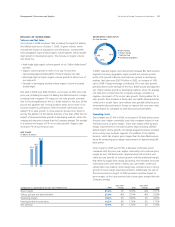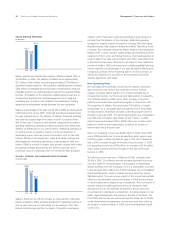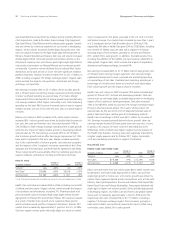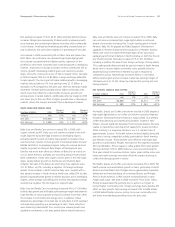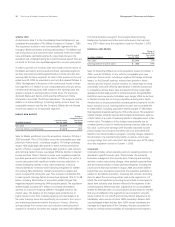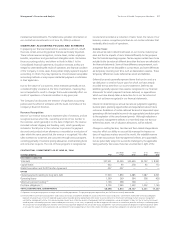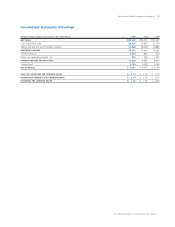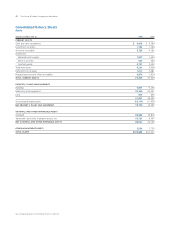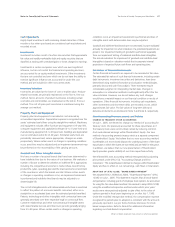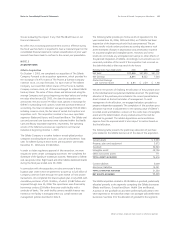Proctor and Gamble 2006 Annual Report Download - page 41
Download and view the complete annual report
Please find page 41 of the 2006 Proctor and Gamble annual report below. You can navigate through the pages in the report by either clicking on the pages listed below, or by using the keyword search tool below to find specific information within the annual report.The Procter &Gamble Company and Subsidiaries 39Management’s Discussion and Analysis
If those criteria are not met, the costs are treated as operating expenses
of the combined company as incurred. Exit costs, consisting primarily
of severance costs, facility closure and other exit costs related to
redundant manufacturing, selling, general and administrative functions,
are based upon plans that have been committed to by management
but which are subject to refinement. Significant estimates and
assumptions are related to the number of employees that will be
terminated and to future costs to operate and eventually vacate
duplicate facilities and to terminate agreements. These estimates and
assumptions may change as we execute approved plans. Decreases to
the estimated costs are generally recorded as an adjustment to goodwill.
Increases to the estimates are generally recorded as an adjustment to
goodwill during the purchase price allocation period (generally within
one year of the acquisition date) and as operating expenses thereafter.
Goodwill and Intangible Assets
Acquired intangible assets may represent indefinite-lived assets
(e.g., certain trademarks or brands), determinable-lived intangibles
(e.g., patents and technologies) or residual goodwill. Of these, only
the costs of determinable-lived intangibles are amortized to expense
over their estimated life. The value of indefinite-lived intangible assets
and residual goodwill is not amortized, but is tested at least annually
for impairment. Our impairment testing for goodwill is performed
separately from our impairment testing of indefinite-lived intangibles.
We test goodwill for impairment, at least annually, by reviewing the
book value compared to the fair value at the reportable unit level. We
test individual indefinite-lived intangibles at least annually by reviewing
the individual book values compared to the fair value. Considerable
management judgment is necessary to evaluate the impact of
operating and macroeconomic changes and to estimate future cash
flows to measure fair value. Assumptions used in the Company’s
impairment evaluations, such as forecasted growth rates and cost of
capital, are consistent with internal projections and operating plans.
When certain events or changes in operating conditions occur,
indefinite-lived intangible assets may be adjusted to a determinable life
and an additional impairment assessment may be performed. We did
not recognize any material impairment charges for goodwill or
intangible assets during the years presented.
The value of goodwill and intangible assets from recently acquired
businesses are derived from current business operating plans and
macroeconomic environmental conditions and therefore are more
susceptible to an adverse change that could require an impairment
charge. Indefinite-lived intangible assets totaled $26.74 billion at June 30,
2006, of which nearly 90% represent recently acquired Gillette
intangible assets. The Gillette indefinite-lived intangible assets were
recorded at estimated fair values as of the acquisition date. Total goodwill
is $55.31 billion at June 30, 2006, of which $35.55 billion results
from the Gillette acquisition. Such goodwill reflects the residual
amount from a purchase price allocation as of the acquisition date.
Because the Gillette intangible and goodwill amounts represent
current values as of the acquisition date, such amounts are more
susceptible to an impairment risk if business operating results or
macroeconomic conditions deteriorate.
New Accounting Pronouncements
As more fully described in Notes 1 and 8 to the Consolidated Financial
Statements, we adopted SFAS 123(Revised 2004), “Share-Based Payment”
(SFAS 123(R)), on July 1, 2005. This Statement requires that all stock-
based compensation, including grants of employee stock options, be
accounted for using the fair value-based method. SFAS 123(R) is
effective for the Company for our fiscal year beginning July 1, 2005.
We elected to adopt SFAS 123(R) using the modified retrospective
method under which prior years’ results were revised to give effect to
the value of options granted in fiscal years beginning on or after July 1,
1995. The additional compensation expense recognized under the
modified retrospective method for periods prior to July 1, 1995 is
consistent with the amounts previously reported in our pro forma
footnote disclosure for stock-based compensation.
In July 2006, the FASB issued FIN 48, “Accounting for Uncertainty in
Income Taxes.” FIN 48 addresses the accounting and disclosure of
uncertain tax positions. We will adopt FIN 48 on July 1, 2007. We are
evaluating the impact, if any, that FIN 48 will have on our financial
statements.
No other new accounting pronouncement issued or effective during
the fiscal year has had or is expected to have a material impact on the
consolidated financial statements.
OTHER INFORMATION
Hedging and Derivative Financial Instruments
As a multinational Company with diverse product offerings, we are
exposed to market risks such as changes in interest rates, currency
exchange rates and commodity prices. To manage the volatility related
to these exposures, we evaluate our exposures on a global basis to
take advantage of the direct netting opportunities and currency, interest
rate and commodity correlations that exist within the portfolio. For
the remaining exposures, we enter into various derivative transactions
in accordance with the Company’s hedging policies that are designed
to offset, in part or in whole, changes in the underlying exposures
being hedged. We do not hold or issue derivative financial instruments
for speculative trading purposes. Note 6 to the Consolidated Financial
Statements includes a detailed discussion of our accounting policies
for financial instruments.
Derivative positions are monitored using techniques including market
valuation, sensitivity analysis and value-at-risk modeling. The tests for
interest rate, currency rate and commodity price exposures discussed
below are based on the CorporateManager™ value-at-risk model using
a one-year horizon and a 95% confidence level. The model incorporates
the impact of correlation (the degree to which exposures move together
over time) and diversification (from holding multiple currency, commodity
and interest rate instruments) and assumes that financial returns are
normally distributed. Estimates of volatility and correlations of market
factors are drawn from the RiskMetrics™ dataset as of June 30, 2006.
In cases where data is unavailable in RiskMetrics™, a reasonable proxy
is included.


